Pyrope, Mg3Al2[SiO4]3, Cubic, Ia3d
< Specimen No. IX-1 >
Specimen No. IX-1, from Seongjin, Korea, is deep brown grains occurring in a placer deposit.
Almandine, Fe3Al2[SiO4]3, Cubic, Ia3d
< Specimens No. IX-2—No. IX-10 >
Specimens No. IX-2—No. IX-7, from the Ishikawa District, Fukushima
Pref., occur in a granitic pegmatite, and form deep brown trisoctahedra with
n(211). The largest crystal measures 1 cm in diameter (Fig. 97).

Specimens No. IX-8-No. IX-10, from Yamanoo, Ibaraki Pref., are reddish
brown trisocathedral crystals in a granite pegmatite in association with quartz,
orthoclase and muscovite. They are 1 cm in average diameter (Fig. 98).

Spessartine, Mn3Al2[SiO4]3, Cubic, Ia3d
< Specimens No.IX-11—No. IX-13 >
Specimens No. IX-11—No. IX-13, from Wadatoge, Nagano Pref., occur in an andesitic obsidian as deep brown single crystals with the combination of n(211) and d(110). They are about 7 mm in size.
Grossular, Ca3Al2[SiO4]3, Cubic, Ia3d
< Specimens No. IX-14—No. IX-24 > (Fig. 99)
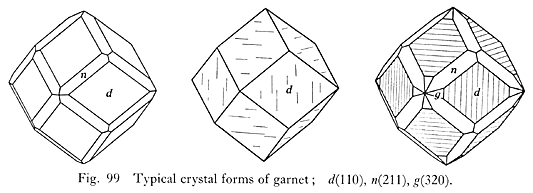
Specimens Nos. IX-14 & IX-15, from Minamizawa, Fukushima Pref., occur in a contact metasomatosed limestone, and form dark brownish dodecahedra consisting of d(110) and n(211) and about 1 cm in diameter.
Specimens No, IX-16—No. IX-19, from Tokura, Fukushima Pref., occur in a contact zone of limestone with granite, and form dodecahedra with d(110), up to 2 cm in diameter and brown in colour. Brown prismatic crystals of clinozoisite are associated.
Specimens Nos. IX-20 & IX-21, from the Chichibu Mine, Saitama Pref., occur in a contact metasomatosed zone, forming massive aggregates of pale yellowish brown dodecahedral granular crystals.
Specimen No. IX-22, from Kurodake, Toyama Pref., occurs in a metasomatosed
limestone in contact with a granitic rock, forms brown dodecahedral crystals
about 1 cm across and is associated with crystalline quartz (Fig. 100).

Specimen No. IX-23, from Moonam, Korea, occurs as skarn mineral in a contact metasomatosed limestone. It forms brown to greyish green massive aggregates of granular crystals. In drusy parts in the aggregates, euhedral crystals grow in dodecahedra with d(110) and 2cm in diameter.
Andradite, Ca3Fe23+[SiO4]3, Cubic, Ia3d.
< Specimens No. IX-24—No. IX-26 >
Specimen No.IX-24, from the Sennin Mine, Iwate Pref., is yellowish brown massive aggregates of dodecahedral granular crystals, occurring in a hematite-actinolite skarn in a contact metasomatosed iron deposit.
Specimen No.IX-25, from Kamihogi, Yamaguchi Pref., occurs in a contact metasomatosed limestone as aggregates of yellowish brown crystals dodecahedral with d(110) and 1 cm across.
Specimen No. IX-26, from the Yoshioka Mine, Okayama Pref., occurs as skarn mineral in a contact metasomatosed copper deposit, and forms deep brown trisoctahedral crystals.
Zircon, Zr[SiO4], Tetragonal, I41/amd
< Specimens No. IX-27—No. IX-33 >
Specimens No. IX-27-No. IX-29, from the Naegi District, Gifu Pref.,
are a variety of zircon named " naegite ", and occur in a placer tin deposit
derived from a granitic pegmatite. They form small granular crystals attaining
a few millimeters in diameter. The faces are too rough and dull for accurate
measurements, but s(111) and a(100) are recognized (Fig. 101).
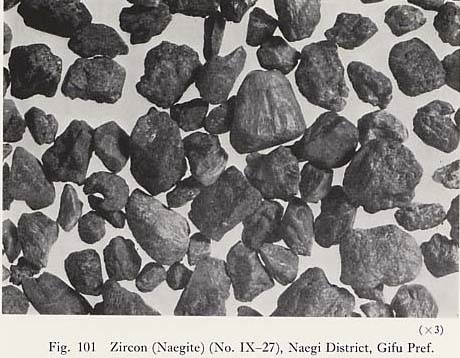
Specimen No. IX-30, from Babutoku, Formosa, is reddish brown granular crystals, occurring in a placer deposit. Faces observed are s(111), π(331) and m(110).
Specimen No. IX-31, from Burma, is rounded grains derived from a placer deposit, white or pale blue and transparent.
Specimens Nos. IX-32 & IX-33, from Carolina, U.S.A., are brown isolated crystals with a(100), s(111), e(101) and λ(311).
Andalusite, AlAl[O|SiO4], Rhombic, Pnnm
< Specimens No. IX-34—No.IX-44 >
Specimen No. IX-34, from Teshirogi, Fukushima Pref., is an aggregate of pale reddish columnar crystals, 10 cm long, in a granitic pegmatite composed of orthoclase, quartz and muscovite, and in association with granular crystals of corundum.
Specimen No. IX-35, from Kosugama, Fukushima Pref., is pinkish brown columnar crystals, 4cm long, in a granitic pegmatite. They are more or less decomposed, and muscovite is formed on the surfaces.
Specimens Nos. IX-36 & IX-37, from Shimojima, Kyoto Pref., are square prismatic crystals in hornfels in a contact aureole of granite. They are pale brown and reach 2 × 2 × 20 mm in size.
Specimens No. IX-38—No. IX-43, from Daisen, Fukuoka Pref., occur in massive aggregates of quartz, orthoclase and muscovite from a granitic pegmatite, and form reddish brown radial aggregates of prismatic crystals, sometimes reaching 8 cm in length.
Specimen No. IX-44, from New South Wales, Australia, is the variety called chiastolite and is embedded in schist, forming cigar-like crystals whose cross sections show a pattern of light and dark areas, owing to accumulation of carbonaceous in clusions according to the symmetry of the crystal.
Topaz, Al2[(F, OH)2|SiO4], Rhombic, Pbnm
< Specimens No. IX-45—No. IX-102 >
Specimens No. IX-45—No. IX-57, from the Naegi District, Gifu
Pref., occur in druses of a granitic pegmatite or in a placer tin deposit
derived from granite. The crystals are in prismatic or short columnar forms
terminated by pinacoidal or pyramidal faces, colourless with bluish tint and
transparent. The largest crystal reaches 7 × 10 × 10 cm in size
(Fig. 102).
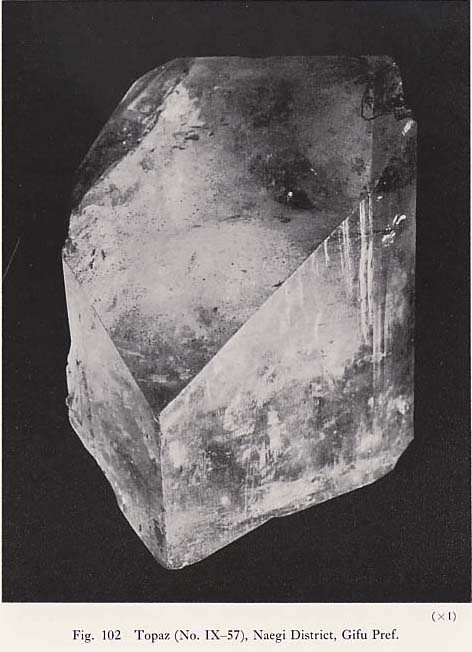
Specimens No. IX-58—No. IX-96, from the Ebisu Mine, Gifu Pref.,
are colour less and transparent short prismatic crystals, occurring in a quartz
vein in a pneumatolytic tungsten-tin-molybdenum deposit. On 39 isolated crystals,
large and common faces are m(110), l(120) and f(011). Common but smaller are
d(101), u(112), o(111) and n(140), and c(001) is observed in 16 crystals.
The other faces observed are i(113) and y(021), but b(010) and h(103) are
rare. They are 2 cm in average length (Fig. 103).
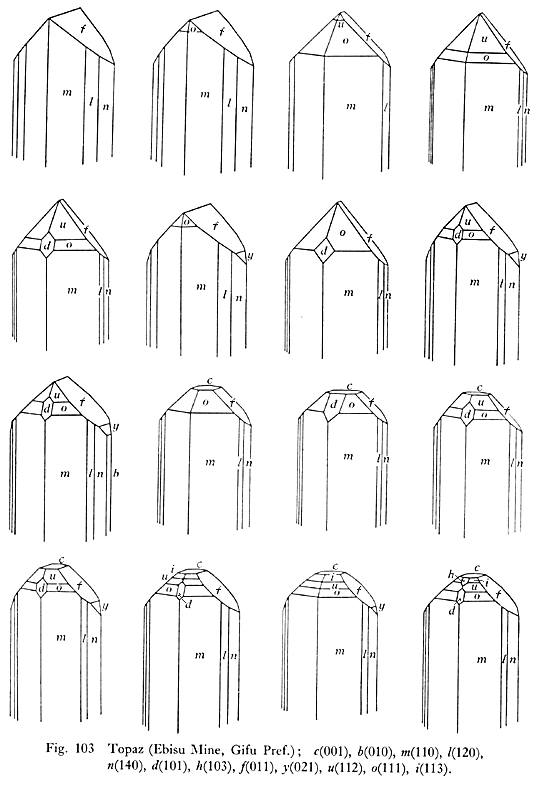
Specimen No.IX-97, from Fukuokamachi, Gifu Pref., occurs in a druse of a granitic pegmatite as transparent prismatic crystals terminated by pyramidal faces.
Specimens Nos.IX-98 & IX-99, from Tanakamiyama, Shiga Pref., occur on muscovite and smoky quartz in druses of a granitic pegmatite as transparent short prismatic crystals terminated by pinacoidal faces.
Specimen No. IX-100, from Suishodani, Tanakamiyama, Shiga Pref., occurs as vein mineral in massive aggregates in granite, and is yellowish white and translucent. It is associated with muscovite.
Specimen No. IX-101, from the Sasagase Mine, Shimane Pref., is white, translucent and massive aggregates, and occurs as vein mineral in a wolframite-bearing quartz vein.
Specimen No.IX-102, from the Boavista Mine, Brazil, is a pale yellowish brown and transparent crystal without terminal faces and 15 mm long.
Sphene, CaTi[O|SiO4], Monoclinic, C2/c
< Specimens No.IX-103—No. IX-105 >
Specimen No. IX-103, from Yoshigahara, Gifu Pref., occurs as accesory mineral in a granitic syenite and is associated with hornblende and plagioclase. The crystals are yellowish brown and up to 3 mm in length. Faces observed are c(001), n(111) and a(100).
Specimens Nos. IX-104 & IX-105, from the Mozumi Deposit of the Kamioka Mine, Gifu Pref., occur as accesory mineral in a granitic syenite and are associated with hornblende and plagioclase. The crystals are yellowish brown and 15 mm across.
Chloritoid, Fe22+AlAl3[(OH)4|O2|(SiO4)2],
Monoclinic, C![]() or C2/c
or C2/c
< Specimens Nos. IX-106 & IX-107 >
Specimen No. IX-106, from Miyata, Ibaraki Pref., is small lamellar crystals up to 3 mm across found in an argillaceous schist in low metamorphosed belts. It is dark grey in colour and sometimes exhibits a radial texture.
Specimen No. IX-107, from the Suwa Mine, Ibaraki Pref., is dark grey small micaceous crystals spotted in graphite-schist. The crystals reach about 1 mm in diameter.
Datolite, CaB[OH|SiC4], Monoclinic, P21/a
< Specimen No. IX-108 >
Specimen No. IX-108, from Yamaura, Miyazaki Pref., occurs on axinite
crystals as product of contact metasomatism, and forms white and transparent
crystals, less than 1 cm in diameter and with x(102) and ε(![]() 12).
12).
Lievrite, CaFe22+Fe3+[OH|O|Si2O7], Rhombic, Pcmn
< Specimens No. IX-109—No. IX-111 >
Specimen No. IX-109, from the Kusakura Mine, Niigata Pref., forms masses in whose cavities its crystals occur, black in colour and prismatic in form. These crystals are associated with actinolitized hedenbergite of a contact deposit.
Specimen No. IX-110, from the Hideya Mine, Niigata Pref., occurs in a contact iron deposit as short prismatic crystals with m(110), s(120), p(101) and o(111), and up to about 1 cm in length.
Specimen No. IX-111, from the Kamioka Mine, Gifu Pref., occurs as
black prismatic crystals, reaching 25 mm in length, in a quartz-calcite-apophyllite
vein cutting through a hedenbergite skarn which is partially altered into
actinolite. Faces observed on the crystals are m(110), s(120), p(101) and
o(111) (Fig. 104).

Hemimorphite, Zn4[(OH)2|Si2O7]H2O, Rhombic, Imm2
< Specimens No. IX-112—No. IX-121 >
Specimens Nos. IX-112 & IX-113, from the Kamioka Mine, Gifu Pref., occur as secondary mineral in a weathered zinc ore, and form botryoidal incrustations of white fine acicular crystals with a banded texture.
Specimen No. IX-114, from the Kamegai Mine, Toyama Pref., occurs as secondary product from sphalerite in a contact deposit. It forms white botryoidal incrustations of minute acicular crystals.
Specimens Nos. IX-115 & IX-116, from the Omine Mine, Yamaguchi Pref., occur in cavities of limonitized ores in a weathered zinc deposit, and form botryoidal incrustations of radially arranged acicular crystals 1 mm long.
Specimens Nos. IX-117 & IX-118, from the Kiura Mine, Oita Pref., are
white botryoidal aggregates of acicular crystals in cavities of limonite in
a weathered zinc deposit (Fig. 105).

Specimen No. IX-119, from the Obira Mine, Oita Pref., occurs in cavities of limonite in a weathered zinc deposit, and forms botryoidal aggregates of acicular crystals a few millimeters long.
Specimen No. IX-120, from Majeon-ri, Korea, occurs in association with smithsonite in fractures of limestone, and forms brown to grey botryoidal aggregates.
Specimen No.IX-121, from Techyukhe, U.S.S.R., occurs as secondary product in a weathered zinc deposit, and forms greyish botryoidal aggregates.
Epidote, Ca2(Fe3+,Al)Al2[O|OH|SiO4|Si2O7], Monoclinic, P21/m
< Specimens No. IX-122—No. IX-135 >
Specimens No. IX-122—No. IX-126, from the Arakawa Mine, Akita
Pref., occur in drusy cavities in quartz veins in an epithermal copper deposit,
and form dark green acicular crystals, a few millimeters long and sometimes
in radial aggregation. Faces observed on the crystals are c(001), a(100),
r(![]() 01), i(
01), i(![]() 02)
and n(
02)
and n(![]() 11).
11).
Specimens Nos. IX-127 & IX-128, from the Kamaishi Mine, Iwate Pref., occur in cavities of a magnetite ore associated with quartz in a contact metasomatosed iron deposit, and form radial aggregates of acicular crystals, yellowish green in colour and up to 2 cm in length.
Specimen No. IX-129, from the Sennin Mine, Iwate Pref., occurs in a contact iron deposit, and forms yellowish green fibrous masses.
Specimen No. IX-130, from Yamagoya, Fukushima Pref., is an isolated
crystal from a granitic pegmatite, about 15 mm long, dark green, prismatic
and with c(001), a(100), r(![]() 01),
i(
01),
i(![]() 02) and n(
02) and n(![]() 11)
(Fig. 106).
11)
(Fig. 106).
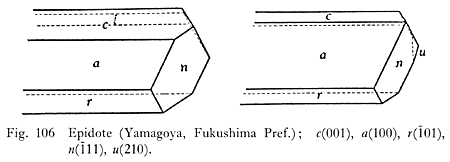
Specimen No. IX-131, from the Kamioka Mine, Gifii Pref., is moss-green aggregates of acicular crystals associated with quartz and sphalerite in a contact metasomatosed lead-zinc deposit.
Specimens Nos. IX-132 & IX-133, from Takeshi, Nagano Pref., occur
in an andesitic tuff as nodular masses, which, when broken, exhibit a drusy
cavity inside with green and transparent needles of epidote 3 mm in length
on the wall. Faces observed on the crystals are c(001), a(100), r(![]() 01),
i(
01),
i(![]() 02) and n(
02) and n(![]() 11)
(Figs. 107 & 108).
11)
(Figs. 107 & 108).


Specimen No. IX-134, from Motoyamamachi, Kochi Pref., is greenish grey prismatic crystals in quartz in chlorite schist.
Specimen No. IX-135, Moonam, Korea, is a deep green prismatic crystal,
2 cm long, from a contact metasomatosed limestone. The principal faces are
c(001), a(100), r(![]() 01), n(
01), n(![]() 11),
l(
11),
l(![]() 01) and i(
01) and i(![]() 02).
02).
Piedmontite, Ca2(Mn3+, Fe3+)Al2[O|OH|SiO4|Si2O7], Monoclinic, P21/m
< Specimens Nos. IX-136 & IX-137 >
Specimen No. IX-136, from Otakiyama, Tokushima Pref., occurs in piedmontiteschist
as vivid reddish purple coloured acicular crystals associated with muscovite
and quartz (Plate 14).

PIEMONTITE (No. IX-136) Otakiyama, Tokushima Pref.
Specimen No. IX-137, from the Besshi Mine, Ehime Pref., occurs as major component of a piedmontite-schist belonging to the Sambagawa metamorphic belts. It forms aggregates of reddish purple acicular crystals.
Allanite, (Ca, Ce)2(Fe2+, Fe3+)Al2[O|OH|SiO4|Si2O7], Monoclinic, P21/m
< Specimens No. IX-138—No. IX-141 >
Specimens Nos. IX-138 & IX-139, from the Ishikawa District, Fukushima Pref., are massive aggregates of prismatic crystals 2 cm long, occurring in a granitic pegmatite in association with quartz and microcline.
Specimen No. IX-140, from Daimonjiyama, Kyoto Pref., is an accesory
mineral in biotite-granite and forms short prismatic crystals 1 × 1
× 5 mm in size and black in colour (Fig. 109).

Specimen No. IX-141, from Mategata, Ehime Pref., is black masses in a granitic pegmatite associated with quartz and microcline, A crystal in the mass measures 5 cm long along the prism edge.
Vesuvianite, Ca10 (Mg, Fe)2Al4 [(OH)4|(SiO4)5|(Si2O7)2], Tetragonal, P4 /nnc
< Specimens No. IX-142—No. IX-161 >
Specimens No. IX-142—No. IX-155, from the Chichibu Mine, Saitama
Pref., occur in metasomatosed parts of limestone in contact with granodiorite,
and in association with yellowish grossular. The crystals exhibit short prismatic
forms such as in specimens Nos. IX-142 & IX-143, sometimes with very short
prism faces such as in specimens Nos. IX-147 & IX-148. Faces observed on the
crystals are e(101), p(111), a(100) and m(110) (Plate 14).

VESUVIANITE (No. IX-148) Chichibu Mine, Saitama Pref.
Specimen No. IX-156, from Hokizawa, Kanagawa Pref., is brown short
prismatic crystals with a(100), e(101) p(111), m(110) and c(001), occurring
in a contact metasomatosed limestone (Fig. 110).
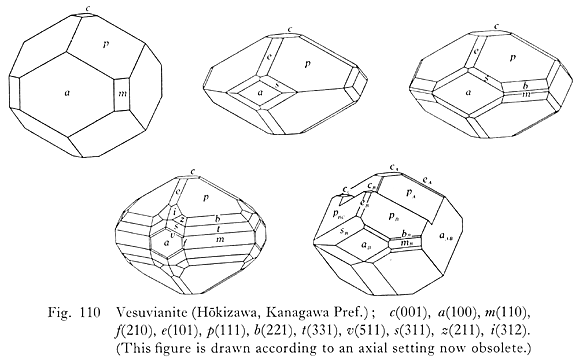
Specimen No. IX-157, from "Kurokura", Kanagawa Pref., occurs in a contact metasomatosed limestone as well-defined granular crystals, 1 cm across and with e(101), p(111), a(100), c(001) and m(110).
Specimens No. IX-158—No. IX-161, from the Kiura Mine, Oita Pref., are deep brown masses found in a contact metasomatosed limestone. In drusy cavities in the masses, crystals of vesuvianite grow in short prisms with c(001), p(111), a(100) and m(110). They are a few millimeters long.
Beryl, Al2Be3[Si6O18], Hexagonal, P6/mcc
< Specimens No. IX-162—No. IX-181 >
Specimens No. IX-162—No. IX-168, Ishikawayama, Fukushima Pref.,
occur in a granitic pegmatite, and are pale yellowish green, transparent and
hexagonal columnar crystals reaching 7 cm and 5 cm in length and diameter
respectively (Plate 14).

BERYL (No. IX-168) Ishikawa District, Fukushima Pref.
Specimens Nos. IX-169 & IX-170, from Tomaki, Ishikawa District, Fukushima
Pref., occur in a granitic pegmatite as pale green and translucent columnar
crystals reaching 9 cm and 8 cm in length and diameter respectively. Their
faces are a(10![]() 0) and c(0001).
0) and c(0001).
Specimens Nos. IX-171 & IX-172, from Yamanoo, Ibaraki Pref., are greenish
white, transparent and hexagonal columnar crystals found in a granitic pegmatite
and are associated with quartz, microcline, muscovite and tourmaline. The
largest crystal is 3 cm in length (Fig. 111).
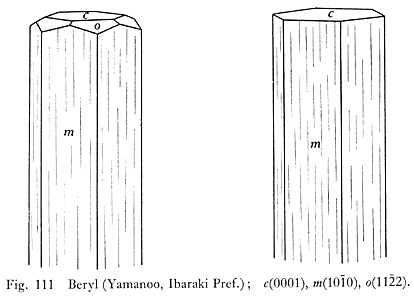
Specimen No. IX-173, from the Naegi District, Gifu Pref., is a pale green and transparent prismatic crystal, 3 cm long and with striations parallel to the c axis.
Specimen No. IX-174, from Kaminagi, Gifu Pref., is pale bluish, transparent and prismatic crystals in a quartz vein cutting through a granitic pegmatite. The crystals measure 1 cm in length on an average.
Specimen No. IX-175, from Tanakamiyama, Shiga Pref., occurs in a druse
of a granitic pegmatite and is a pale green, transparent and columnar crystal,
3 cm long and with a(10![]() 0), p(10
0), p(10![]() 1)
and c(0001).
1)
and c(0001).
Specimen No. IX-176, from Nagatare, Fukuoka Pref., is a pale yellowish green massive aggregate occurring in a granitic pegmatite.
Specimens Nos. IX-177 & IX-178, from Olvyannaya, U.S.S.R., occur in quartz from a granitic pegmatite as pale yellowish green, translucent and hexagonal prismatic crystals up to 4 cm in length.
Specimen No. IX-179, from Adownchoron, U.S.S.R., is an aggregate of pale green, translucent and prismatic crystals reaching 3 cm in length and in association with massive arsenopyrite.
Specimens Nos. IX-180 & IX-181, from Brazil, occur in a granitic pegmatite and are pale green and transparent masses showing no crystal faces.
Cordierite, Mg2Al3[AlSi5O18], Rhombic, Cccm
< Specimens No. IX-182—No. IX-195 >
Specimens No. IX-182—No. IX-187, from the Hitachi Mine, Ibaraki Pref., are dark bluish grey prismatic crystals in a quartz vein in mica schist. Faces observed on the crystals are a(100), m(110), d(130), b(010) and c(001).
Specimen No. IX-188, from Sangaseyama, Yamanashi Pref., is rough-and-dull shaped short prismatic crystals 2 cm long, and found in biotite-hornfels. Their surfaces are altered into sericite.
Specimens No. IX-189—No. IX-192, from Sakuratenjin, Kyoto Pref.,
are hexagonal prismatic crystals, 15 mm and 8 mm in length and diameter respectively.
They are included in slate as product of contact metamorphism. These crystals
exhibit flower-shaped cross sections due to penetration trilling of hexagonal
prismatic crystals almost decomposed into sericite (Plate 14).
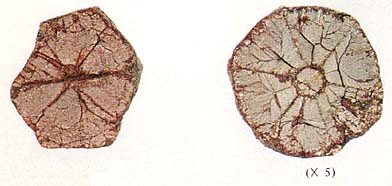
CORDIERITE (CERASITE) (No. IX-189) Kameoka-hachiman, Kyoto Pref.
Specimen No. IX-193, from Torihama, Fukui Pref., occurs as porphyroblasts in hornfels showing rough-shaped prismatic crystals 2 cm long and 7 mm across. The crystals are usually decomposed, but the central part is often found to be fresh.
Specimens Nos. IX-194 & IX-195, from Umenokigawa, Kuka Mine, Yamaguchi Pref., occur as porphyroblasts in biotite-hornfels, and form small short prismatic crystals partially altered into sericite.
Elbaite, Na(Li, Al)3Al6[(OH)1+3|(BO3)3|Si6O18], Trigonal, R3m
< Specimen No. IX-196 >
Specimen No. IX-196, from San Diego County, California, U.S.A., is a hexagonal columnar crystal 3 cm long and 15 mm across, and is pink near the centre and transparent. This crystal came from a granitic pegmatite.
Schorl, NaFe32+Al6[(OH)1+3|(BO3)3|Si6O18], Trigonal, R3m
< Specimens No. IX-197—No. IX-207 >
Specimens No. IX-197—No. IX-202, from the Ishikawa District,
Fukushima Pref., occur in a granitic pegmatite composed of quartz, microcline
and muscovite. The crystals are columnar, pitch-black and opaque. Faces observed
on them are a(11![]() 0),
m(10
0),
m(10![]() 0), r(10
0), r(10![]() 1)
and o(02
1)
and o(02![]() 1).
1).
Specimen No. IX-203, from Shiozawa, Ishikawa District, Fukushima Pref.,
is a black columnar crystal, 1 × 1 × 2 cm in size, and occurs
in a granitic pegmatite. Its faces are a(11![]() 0),
m(10
0),
m(10![]() 0), r(10
0), r(10![]() 1)
and o(02
1)
and o(02![]() 1) (Fig. 112).
1) (Fig. 112).

Specimens No. IX-204—No. IX-206, from Goshodaira, Nagano Pref.,
occur as isolated crystals in a granitic pegmatite. The crystals, up to 6
cm across, have very short and rough prismatic faces terminated by r(10![]() 1).
Quartz and muscovite grow on their surfaces.
1).
Quartz and muscovite grow on their surfaces.
Specimen No. IX-207, from the Obira Mine, Oita Pref., occurs in quartz in a contact deposit as bundle-shaped aggregates of black acicular crystals 5 cm long.
Diopside, CaMg[Si2O6], Monoclinic, C2/c
< Specimens No. IX-208—No. IX-215 >
Specimen No. IX-208, from the Chichibu Mine, Saitama Pref., occurs
in a contact metasomatosed limestone as greenish grey short prismatic crystals
associated with grossular. The crystals are a few millimeters in size (Fig.
113).

Specimens No. IX-209—No. IX-211, from Hokizawa, Kanagawa Pref., occur in a contact metasomatosed dolomite as greenish grey aggregates of granular crystals associated with granular garnet and white small acicular crystals of natrolite.
Specimens No. IX-212—No. IX-215, from Kamisano, Yamanashi Pref.,
occur as phenocrysts in porphyrite. The crystals are dark green and short
prismatic up to 4cm and with a(100), b(010), m(110) and s(![]() 11),
and some of them contain small amounts of chromium. Twins are frequent as
in specimen No. IX-214.
11),
and some of them contain small amounts of chromium. Twins are frequent as
in specimen No. IX-214.
Hedenbergite, CaFe[Si2O6], Monoclinic, C2/c
< Specimens No. IX-216—No. IX-227 >
Specimens No. IX-216—No. IX-218, from the Kamioka Mine, Gifu
Pref., occur both in single crystals and in massive aggregates as skarn mineral
associated with sphalerite and partially altered into actinolite in a contact
deposit. The single crystals are prismatic with a(100), b(010), p(![]() 01)
and c(001), 7mm in length on an average and deep green in colour.
01)
and c(001), 7mm in length on an average and deep green in colour.
Specimen No. IX-219, from the Sasagatani Mine, Shimane Pref., occurs in a contact copper deposit as massive aggregates of needle-shaped or prismatic crystals, some of which contain more than 4.5% of MnO.
Specimens Nos. IX-220 & IX-221, from the Kiura Mine, Oita Pref., occur as skarn mineral associated with fluorite, chalcopyrite and quartz in a contact deposit, and form columnar or tabular crystals with a(100), v(111), m(110), b(010) and c(001), larger than 6 cm in size and dark green in colour.
Aegirine-Augite, NaFe3+[Si2O6], Monoclinic, C2/c
< Specimen No. IX-222 >
Specimen No. IX-222, from Taedong, Korea, occurs in an alkali-granite pegmatite, associated with quartz and orthoclase. It forms short columnar crystals up to 3 × 3 × 6 cm in size and black in colour.
Common augite, (Ca, Mg, Fe2+, Fe3+, Ti, Al)2[(Si, Al)2O6], Monoclinic, C2/c
< Specimens No. IX-223—No. IX-228 > (Fig. 114)
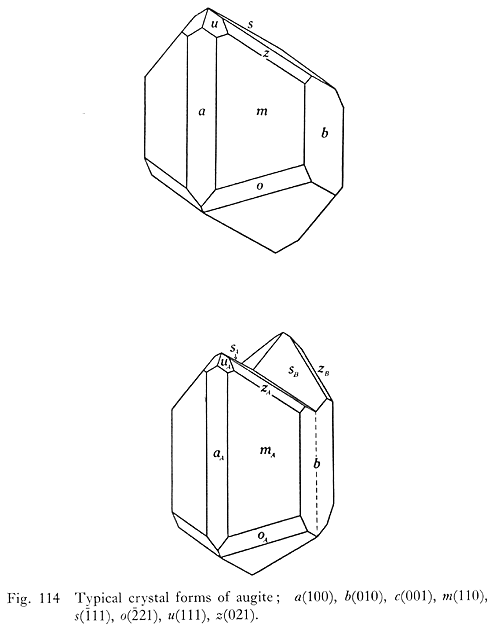
Specimens Nos. IX-223 & IX-224, from Yoneyama, Niigata Pref., occur as phenocrysts in andesite and form black short prismatic crystals. Twins up to 1 cm in size appear.
Specimen No. IX-225, from Tateshinayama, Nagano Pref., is isolated
crystals from andesite. They are black short prismatic crystals up to 1 cm
in length and with a(100), b(010), m(110) and s(![]() 11).
11).
Specimens Nos. IX-226 & IX-227, from Nishigatake, Saga Pref., are
isolated crystals from a decomposed basalt. They are green short prismatic
crystals, 1 cm long on an average and with a(100), m(110), b(010) and s(![]() 11),
and often show twinning on a(100) (Fig. 115).
11),
and often show twinning on a(100) (Fig. 115).
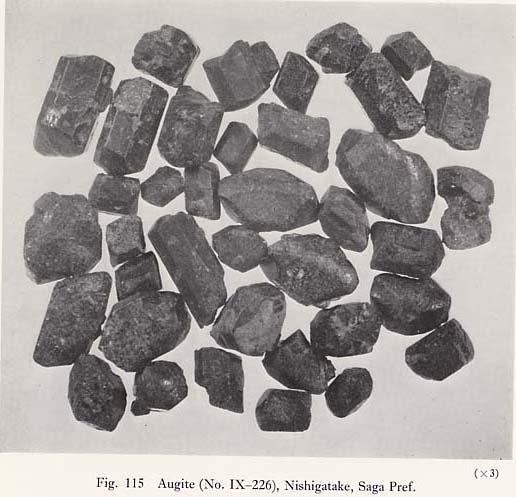
Specimen No. IX-228, from Shabozan, Formosa, occurs in andesite as greenish
black short prismatic crystals up to 5 mm in length. Faces observed on the
crystals are a(100), b(010), m(110) and s(![]() 11).
11).
Bronzite, (Mg, Fe)2[Si2O6], Rhombic, Pbca
< Specimens No. IX-229—No. IX-233 >
Specimens No. IX-229—No. IX-233, from Takinoura, Anijima Isl.,
Tokyo, occur in a glassy andesite as dark green short prismatic crystals up
to a few millimeters in length. Faces observed on the crystals are a(100),
m(110), b(010), s(![]() 11) and e(011),
Its composition is nearly equal to FeSiO3+6MgSiO3.
11) and e(011),
Its composition is nearly equal to FeSiO3+6MgSiO3.
Actinolite, Ca2(Mg, Fe2+)5[OH|Si4O11]2, Monoclinic, C2/m
< Specimens No. IX-234—No. IX-238 >
Specimen No.IX-234, from the Sennin Mine, Iwate Pref., is an alteration product of hedenbergite in a contact iron deposit, and forms greyish aggregates of fibrous crystals.
Specimen No. IX-235, from the Kamaishi Mine, Iwate Pref., occurs in a drusy part of a magnetite ore from a contact metamorphic iron deposit, and forms deep green aggregates of acicular crystals.
Specimens Nos. IX-236 & IX-237, from Yoshino, Kochi Pref., occur in
talcose parts of a crystalline schist as green prismatic or fibrous crystals
up to 5 cm in length and without terminal faces (Fig. 116).
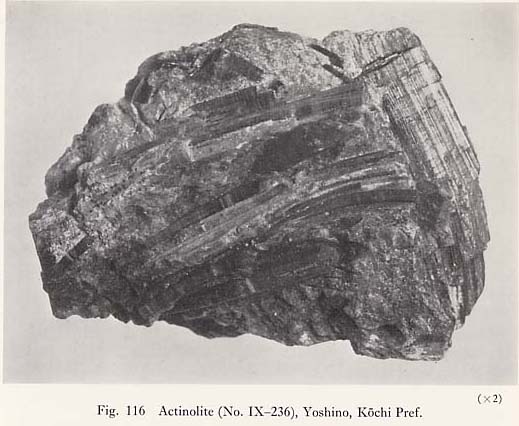
Specimen No. IX-238, from Yanagigaura, Fukuoka Pref., occurs in a massive magnetite ore from a contact iron deposit as a light grey to greenish grey aggregate of fibrous crystals.
Common hornblende, (Ca, Na)2—3(Mg, Fe2+, Fe3+, Al)5[(OH)2|(Si, Al)2Si6O22], Monoclinic, C2/m
< Specimens No. IX-239—No. IX-247 > (Fig. 117)
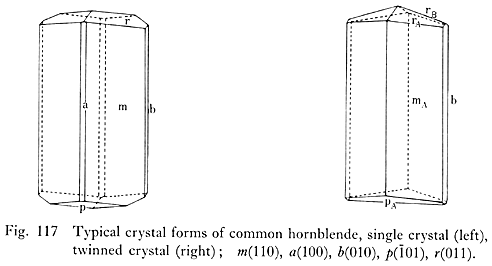
Specimen No. IX-239, from Jitsusawa, Fukushima Pref., occurs in a gabbroic pegmatite as a massive aggregate of black prismatic crystals.
Specimens Nos. IX-240 & IX-241, from Eimyosan, Nagano Pref., occur as phenocrysts in an andesitic lava, and form short prismatic crystals up to 1 cm in ength.
Specimen No. IX-242, from Tonoshiro, Nagano Pref., occurs as phenocrysts in an andesitic rock, forming black prismatic crystals up to 2 cm in length.
Specimens No. IX-243—No. IX-245, from Sanjukyo, Formosa, occur as phenocrysts in andesite, forming prismatic crystals up to 2 cm in length. Sometimes twins on (100) appear.
Specimen No. IX-246, from Daitonzan, Formosa, occurs in andesite as phenocrysts, forming elongated prisms and twins. They are about 15 mm in length.
Specimen No, IX-247, from Keonchun-ri, Korea, occurs as phenocrysts in an alkali-granite, forming black prismatic crystals in association with fluorite.
Wollastonite, Ca3[Si3O9], Triclinic,
P![]()
< Specimens No. IX-248—No. IX-252 >
Specimen No, IX-248, from Tokura, Fukushima Pref., occurs in a contact metasomatosed limestone as a white massive aggregate of fibrous crystals associated with garnet.
Specimen No. IX-249, from Ishiyamadera, Shiga Pref., occurs in a contact metasomatosed limestone, forming massive aggregates of fibrous crystals.
Specimen No. IX-250, from Shimoyama, Fukui Pref., occurs in a contact metasomatosed limestone as an aggregate of fibrous crystals with silky lustre.
Specimen No. IX-251, from the Yamato (Ofuku) Mine, Yamaguchi Pref., occurs in a contact metasomatosed limestone as an aggregate of fibrous crystals with silky lustre.
Specimen No. IX-252, from the Kiura Mine, Oita Pref., occurs in a contact metasomatosed limestone as a massive aggregate of white fibrous crystals associated with arsenopyrite.
Pectolite, Ca2NaH[Si3O9], Triclinic,
P![]()
< Specimens No. IX-253—No. IX-255 >
Specimens No. IX-253—No. IX-255, from Uenbetsu, Hokkaido, occur in serpentinite as a vein consisting of radial aggregates of transparent acicular crystals.
Inesite, Ca2Mn7[Si5O14OH]2·5H2O,
Triclinic, P![]()
< Specimens No. IX-256—No. IX -262 >
Specimens No. IX-256—No. IX-262, from the Rendaiji Mine, Shizuoka
Pref., occur in drusy cavities in quartz veins and also as vein stuff in an
epithermal gold-silver deposit. They are bundle-shaped or radial aggregates
of minute fibrous crystals up to 1 cm in length. Associated minerals are rhodochrosite
and penwithite (Plate 15).
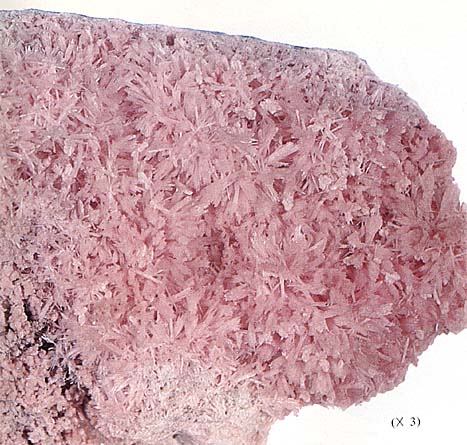
INESITE (No. IX-261) Rendaiji Mine, Shizuoka Pref.
Axinite, Ca2(Fe, Mn)Al2[OH|BSi4O15],
Triclinic, P![]()
< Specimens No. IX-263—No. IX-283 >
Specimens No. IX-263—No. IX-266, from Wanabasawa of the Chichibu Mine, Saitama Pref., occur in drusy parts of massive quartz associated with actinolite in a contact metasomatosed iron deposit. The crystals form groups of small tabular crystals pale purple to purplish grey and transparent.
Specimen No. IX-267, from Hashikakezawa of the Chichibu Mine, Saitama Pref., occurs in drusy parts of a grossular skarn in a contact metasomatosed limestone, and forms purplish grey small crystals up to 2 cm across.
Specimen No. IX-268, from the Ogiyama Mine, Okayama Pref., occurs as product of contact metasomatism in association with calcite. It forms dark brown tabular crystals up to 1 cm across.
Specimens No. IX-269—No. IX-277, from the Obira Mine, Oita Pref.,
are a product of pneumatolytic metasomatism in association with crystalline
quartz, and the crystals grow in aggregates in drusy cavities. They are dark
brown, transparent, up to 9 cm in length, and with M(1![]() 0),
m(110), x(1
0),
m(110), x(1![]() 1) and r(111) as dominant
faces, and exhibit radial or sub-parallel growth. Axinite from this locality
contains an appreciable amount, up to 5.2%, of manganese (Plate 15).
1) and r(111) as dominant
faces, and exhibit radial or sub-parallel growth. Axinite from this locality
contains an appreciable amount, up to 5.2%, of manganese (Plate 15).

AXINITE (No. IX-270) Obira Mine, Oita Pref.
Specimen No. IX-278, from the Shodo Deposit of the Obira Mine, Oita Pref., occurs in a contact metasomatosed deposit as single crystals or radial aggregates. The crystals are brown and transparent, up to a few centimeters in diameter.
Specimen No. IX-279, from the Okura Deposit of the Obira Mine, Oita
Pref., is deep brown crystals, up to 1 cm in length, occurring in a contact
metasomatosed deposit. Their principal faces are Y(![]() 31),
M(1
31),
M(1![]() 0), a(100), m(110), b(010)
and z(1
0), a(100), m(110), b(010)
and z(1![]() 2).
2).
Specimen No. IX-280, from the Kiura Mine, Oita Pref., occurs in a
contact metasomatosed deposit as one of its skarn minerals. The crystals are
deep brown and up to 1 cm in diameter. Faces observed on the crystals are
Y(![]() 31), M(1
31), M(1![]() 0),
a(100), m(110), b(010) and z(1
0),
a(100), m(110), b(010) and z(1![]() 2).
2).
Specimens No. IX-281—No. IX-283, from Yamaura, Miyazaki Pref.,
occur in drusy cavities surrounded by crystalline quartz in a contact metasomatosed
deposit, and form groups or aggregates of tabular or prismatic crystals, which
are sometimes in sub-parallel growth. The crystals are brown to dark purplish
brown and transparent to translucent. Their faces are M(1![]() 0),
a(100), m(110), s(201), r(111) and x(1
0),
a(100), m(110), s(201), r(111) and x(1![]() 1).
1).
Apophyllite, KCa4[F|(Si4O10)2]·8H2O, Tetragonal, P4/mnc
< Specimens No. IX-284—No. IX-292 >
Specimens Nos. IX-284 & IX-285, from Omura, Chichijima Isl., Tokyo, occur in amygdules of andesite, forming pale pink and translucent columnar crystals, sometimes in radial aggregation. Faces a(100) and c(001) are well-developed, while p(111) appears only at the corners.
Specimens Nos. IX-286 & IX-287, from Maze, Niigata Pref., occur in cavities of andesite as pale blue and transparent crystals up to about 2 cm across. They are associated with calcite and analcime. Faces observed on the crystals are p(111), c(001) and a(100).
Specimens No. IX-288—No. IX-292, from the Kamioka Mine, Gifu
Pref., occur in fractures of a hedenbergite skarn associated with sphalerite.
The crystals bear short prismatic habit with square prism faces, and the cleavage
plane on (001) gives a pearly look. Faces dominant are a(100) and p(111) (Plate
16, Fig. 118).
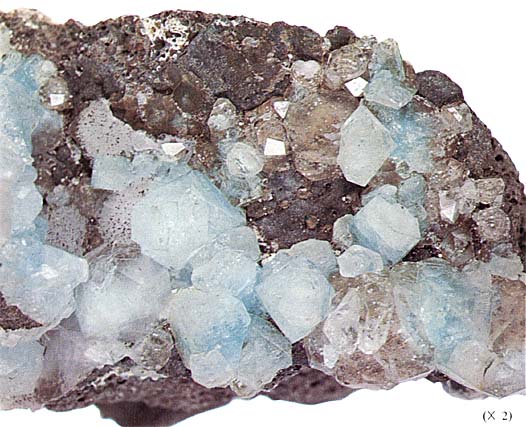
APOPHYLLITE (No. IX-287) Maze, Niigata Pref.

Pyrophyllite, Al2[(OH)2|Si4O10], Monoclinic, C2/c or Cc
< Specimen No. IX-293 >
Specimen No. IX-293, from Mituishi, Okayama Pref., occurs as light grey masses in a hydrothermally altered clay deposit.
Talc, Mg3[(OH)2|Si4O10], Monoclinic, C2/c or Cc
< Specimens Nos. IX-294 & IX-295 >
Specimen No. IX-294, from Tairei, China, is a dull yellow massive aggregate with waxy lustre.
Specimen No. IX-295, from Enkakoku, China, is a creamy yellow massive aggregate.
Muscovite, KAl2[(OH, F)2|AlSi3O10, Monoclinic, C2/c
< Specimens Nos. IX-296 & IX-297 >
Specimen No. IX-296, from Tanakamiyama, Shiga Pref., is pearly white tabular crystals in rough hexagonal outline and up to 7 cm across. It occurs in a granitic pegmatite.
Specimen No. IX-297, from Nagatare, Fukuoka Pref., is feather-like aggregates of pearly white lamellar crystals associated with quartz and orthoclase in a greizenized granite.
Phlogopite, KMg3[(OH, F)2|AlSi3O10], Monoclinic, C2/m
< Specimens Nos. IX-298 & IX-299 >
Specimens Nos. IX-298 & IX-299, from Sekiyama, Yamaguchi Pref., occur in amygdules in basalt as thin hexagonal lamellar crystals, pale brown, transparent and a few millimeters across.
Lepidolite, K(Li, Al)3[F2|(Si, Al)4O10], Monoclinic, C2/m
< Specimen No. IX-300 >
Specimen No. IX-300, from Nagatare, Fukuoka Pref., is a pale purple massive aggregate of fine lamellar crystals occurring in a granitic pegmatite.
Zinnwaldite, KLiFe2+Al[F2|AlSi3O10], Monoclinic, C2/m
< Specimens Nos. IX-301 & IX-302 >
Specimens Nos. IX-301 & IX-302, from Tanakamiyama, Shiga Pref., occur in drusy cavities of a granitic pegmatite in association with smoky quartz and microcline, and form hexagonal thick tabular crystals up to 8 cm across and pearly white to grey in colour.
Xanthophyllite, Ca(Mg, Al)2—3[(OH)2|Al2Si2O10], Monoclinic, C2/m or C2/c
< Specimens No. IX-303—No. IX-305 >
Specimens No. IX-303—No. IX-305, from Sekkaizawa of the Chichibu Mine, Saitama Pref., are pale green, transparent and hexagonal tabular crystals included in granular aggregates of vesuvianite in a contact metasomatosed limestone in association with calcite. They are up to 2 mm in diameter.
Hydrobiotite, (K, H2O)Mg3[(H2O, OH)2|AlSi3O10], Monoclinic, C2/m
< Specimens No. IX-306—No. IX-308 >
Specimens Nos. IX-306 & IX-307, from Hajikano, Yamanashi Pref., occur as weathered product from biotite included in granite. It is yellowish brown to brown grains attaining 5 mm across.
Specimen No. IX-308, from Matsugatani, Fukui Pref., occurs as weathering product from biotite in granite. They are yellowish brown, rough shaped hexagonal short prisms up to 10 mm across.
Thuringite, (Fe2+, Fe3+, Al)3[(OH)2|Al2Si2O10]·(Mg, Fe2+, Fe3+)3(O, OH)6, Monoclinic
< Specimens No. IX-309—No. IX-315 >
Specimens No. IX-309—No. IX-315, from Jodosan, Toyama Pref., are deep green massive aggregates included in andradite masses and associated with quartz, hematite and magnetite.
Chamosite, (Fe2+, Fe3+)3[(OH)2|AlSi3O10]·(Fe, Mg)3(O, OH)6, Monoclinic
< Specimens No. IX-316—No. IX-323 >
Specimens No. IX-316—No. IX-322, from the Arakawa Mine, Akita
Pref., occur in drusy cavities of a chalcopyrite-pyrite-quartz vein, forming
deep green botryoidal or stalagmitic aggregates of scales in radial arrangement.
Associated minerals are transparent crystalline quartz and crystals of chalcopyrite
(Fig. 119).
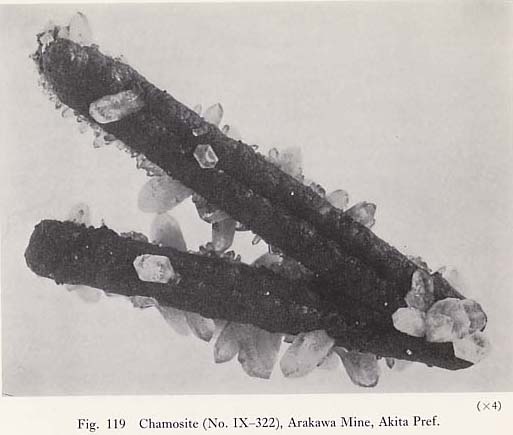
Specimen No. IX-323, from the Akenobe Mine, Hyogo Pref., forms spherical aggregates of radial texture, occurring on crystalline quartz in a quartz vein cutting through rhyolite.
Antigorite, (Mg, Fe)6[(OH)8|Si4O10], Monoclinic, Cm, C2 or C2/m or Hexagonal, P63cm
< Specimen No. IX-324 >
Specimen No. IX-324, from Shugan, China, is a massive aggregate of minute fibrous crystals, and light green in colour with waxy lustre.
Chrysocolla, Cu4H4[(OH)8|Si4O10], Cryptocrystalline
< Specimen No. IX-325 >
Specimen No. IX-325, from the Rendaiji Mine, Shizuoka Pref., occurs as secondary mineral in an oxidized copper deposit. It forms an incrustation with a banded texture and is light greenish blue in colour with glassy lustre.
Penwithite, MnSiO3·nH2O, Cryptocrystalline
< Specimens No. IX-326—No. IX-328 >
Specimens No. IX-326—No. IX-328, from the Rendaiji Mine, Shizuoka Pref., occur as later-stage product in an epithermal gold-silver-quartz vein, and form deep brown to pale brown glassy masses with conchoidal fractures.
Analcime, Na[AlSi2O6]·H2O, Cubic, Ia3d
< Specimens No. IX-329—No. IX-331 >
Specimens No. IX-329—No. IX-331, from Maze, Niigata Pref., are trisocta-hedral crystals lining vesicular cavities in an andesitic agglomerate and are associated with apophyllite, natrolite and calcite. The crystals reach 15 mm across and with n(211).
Sanidine, K[AlSi3O8], Monoclinic, C2/m
< Specimens No. IX-332—No. IX-334 >
Specimens Nos. IX-332 & IX-333, from Cheung-san, Korea, occur as phenocrysts
in alkali-rhyolite, and form short columnar cystals, 5 mm across, sometimes
exhibiting twinning after the Carlsbad law. Faces c(001), m(110), x(![]() 01)
and b(010) are common in their simple forms. They are pale yellow and transparent,
and occasionally show schillerization like moonstone (Plate 16).
01)
and b(010) are common in their simple forms. They are pale yellow and transparent,
and occasionally show schillerization like moonstone (Plate 16).
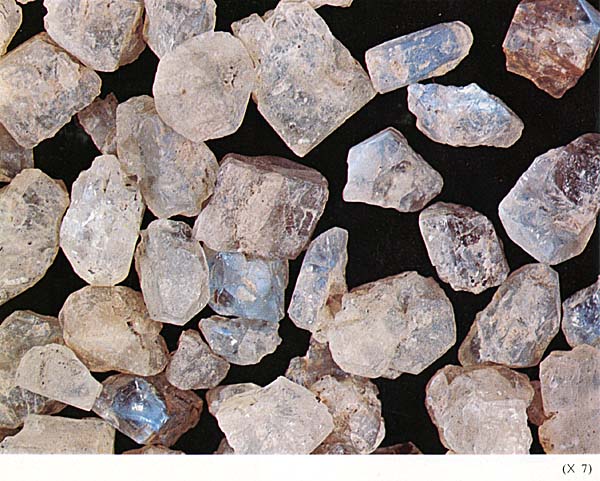
MOONSTONE (No. IX-333) Cheung-san, Korea
Specimen No. IX-334, from Iran, occurs in an acidic volcanic rock, forming a grey tabular crystal.
Orthoclase, K[AlSi3O8], Monoclinic, C2/m
< Specimens No. IX-335—No. IX-343 > (Fig. 120)
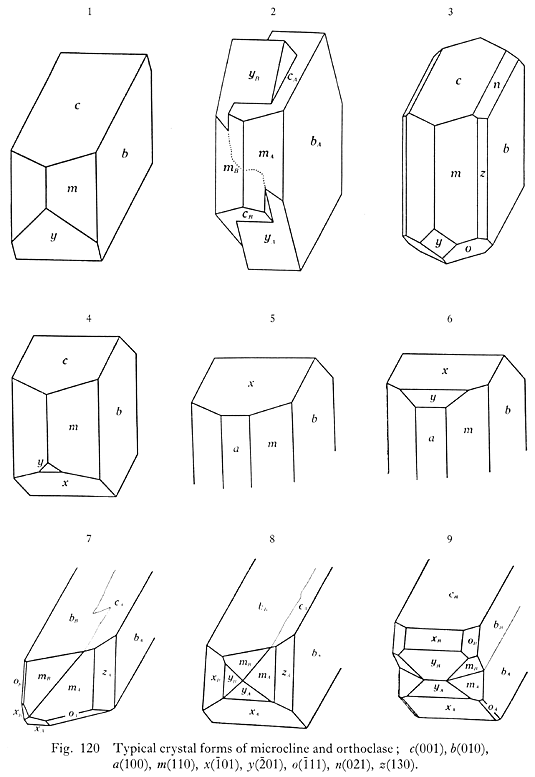
Specimen No. IX-335, from Keumgang-san, Korea, occurs in a drusy cavity
in a granitic pegmatite, forming groups of short columnar crystals up to 4
cm along the edge, brown in colour and with c(001), m(110) x(![]() 01)
and b(010).
01)
and b(010).
Adularia (Variety of orthoclase)
< Specimens No. IX-336—No. IX-343 > (Fig. 121)

Specimens No. IX-336—No. IX-339, from the Takatama Mine, Fukushima
Pref., occur as gangue mineral in an epithermal gold-silver-quartz vein. The
crystals in drusy parts form apparent rhombohedra with m(110), c(001) and
x(![]() 01), and are transparent to
translucent.
01), and are transparent to
translucent.
Specimens Nos. IX-340 & IX-341, from Yarnanoo, Ibaraki Pref., occur
in drusy cavities in a granitic pegmatite composed of quartz, orthoclase,
muscovite and garnet, and form crystals apparently rhombohedral and intimately
associated with orthoclase. Common forms are the combination of c(001), m(110)
and x(![]() 01).
01).
Specimen No. IX-342, from the Tasei Deposit of the Ikuno Mine, Hyogo Pref., occurs as gangue mineral in a gold-silver-bearing quartz vein. It is a pale pink granular aggregate.
Specimen No. IX-343, from the Holgol Mine, Korea, occurs on crystalline
quartz in drusy cavities in a contact metasomatosed copper deposit. Its crystals
are rhombohedra with c(001), m(110) and x(![]() 01),
colourless and transparent.
01),
colourless and transparent.
Microcline, K[AlSi3O8], Triclinic, C![]()
< Specimens No. IX-344—No. IX-364 >
Specimens No. IX-344—No. IX-346, from the Ishikawa District, Fukushima
Pref., occur in druses in a granitic pegmatite, and form short columnar crystals
with the faces of c(001), m(110), x(![]() 01)
and b(010), and also Carlsbad twins.
01)
and b(010), and also Carlsbad twins.
Specimens Nos. IX-347 & IX-348, from Tadachi, Nagano Pref., occur
in druses in a granitic pegmatite. They are the light green coloured variety
called " amazonite ", and in a simple form consisting of c(001), m(110), x(![]() 01)
and b(010).
01)
and b(010).
Specimen No. IX-349, from Moraiyama, Nagano Pref., occurs in a granitic
pegmatite, and forms short columnar twins after the Baveno law. Faces observed
are z(130), o(![]() 11) and b(010).
11) and b(010).
Specimens Nos. IX-350 & IX-351, from Otome (Kurasawa) Mine,
Yamanashi Pref., occur in druses in a granitic pegmatite in association with
smoky quartz, and form columnar crystals and their Baveno twins. Faces observed
are m(110), y(![]() 01),
x(
01),
x(![]() 01), z(130), o(
01), z(130), o(![]() 11)
and b(010) as in the specimen No. IX-351.
11)
and b(010) as in the specimen No. IX-351.
Specimen No. IX-352, from the Otome (Otomezaka) Mine, Yamanashi
Pref., occurs in a drusy cavity in a granitic pegmatite, and forms creamy
white crystals in a simple form consisting of c(001), m(110), x(![]() 01)
and b(010).
01)
and b(010).
Specimens No. IX-353—No. IX-358, from Naegi District, Gifu Pref.,
occur in drusy cavities in a granitic pegmatite, and form square columnar
crystals attaining 4 cm in length. The main faces observed are c(001), m(110),
x(![]() 01), o(
01), o(![]() 11)
and b(010). Most of them are twinned after the Carlsbad law (Fig. 122).
11)
and b(010). Most of them are twinned after the Carlsbad law (Fig. 122).
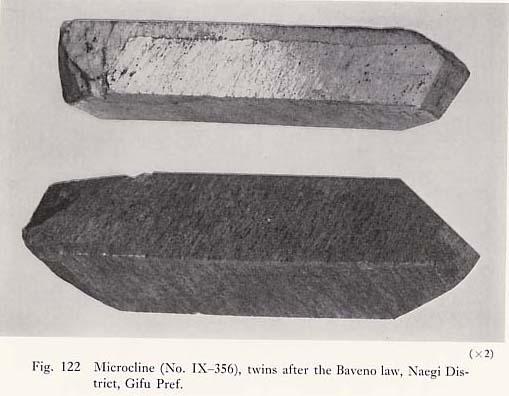
Specimens No. IX-359—No. IX-363, from Tanakamiyama, Shiga Pref.,
occurin druses in a granitic pegmatite as columnar crystals associated with
albite and smoky quartz. Faces observed are b(010), m(110), z(130) and o(![]() 11)
in Baveno twins, and c(001), b(010), m(110), z(130), y(
11)
in Baveno twins, and c(001), b(010), m(110), z(130), y(![]() 01)
and x(
01)
and x(![]() 01) in single crystals.
Some of them are twinned also after the Carlsbad law as in specimen No. IX-363.
01) in single crystals.
Some of them are twinned also after the Carlsbad law as in specimen No. IX-363.
Specimen No. IX-364, from Shodoshima Isl., Kagawa Pref., occurs in
drusy cavities in a granitic pegmatite in association with albite and smoky
quartz. Its crystals are in short columnar forms and also in Carlsbad twins.
The main faces are c(001), m(110), x(![]() 01)
and b(010).
01)
and b(010).
Albite, (An 0-10), Na[AlSi3O8], Triclinic, C![]()
< Specimens No. IX-365—No. IX-369 >
Specimen No. IX-365, from Sueno, Saitama Pref., occurs as albite-quartz vein in chlorite-schist. It forms a white massive aggregate and its individual crystals are rarely sufficiently distinct to allow an accurate determination, the only faces recognizable being b(010).
Specimens Nos. IX-366 & IX-367, from the Naegi District, Gifu Pref., occurin druses in a granitic pegmatite, and form aggregates of tabular crystals intimately associated with microcline.
Specimen No. IX-368, from Tanakamiyama, Shiga Pref., occurs in druses in a granitic pegmatite associated with microcline and muscovite. It forms an aggregate of white tabular crystals.
Specimen No. IX-369, from Shibuta, Wakayama Pref., occurs as a vein cutting through chlorite-schist, and forms white, translucent and tabular crystals in its druses.
Andesine, (An 30-50), Triclinic, C![]()
< Specimens No. IX-370—No. IX-372 >
Specimens Nos. IX-370 & IX-371, from Nakaiojima Isl., Tokyo, occur
as isolated, crystals from a weathered andesitic lava. They are tabular in
form and 1 cm in size, but their faces are not well developed. Some of them
show cross twinning. The crystals are always coated with black glassy lava
(Fig. 123).

Specimen No. IX-372, from Maeyama, Nagano Pref., occurs in an andesitic tuff. Isolated crystals are white, translucent, short prismatic, and up to 5 mm in size. They sometimes show cross twinning, hence the local name " Chigai-ishi " (cross-stone).
Anorthite, (An 90-100), Ca[Al2Si2O8],
Triclinic, P![]()
< Specimens No. IX-373—No. IX-381 >
Specimens No. IX-373—No. IX-380, from Miyakejima Isl., Tokyo,
are crystals ejected during the eruption, in 1870, of the volcano in this
island. They short are prismatic crystals up to 2 cm in diameter and covered
with a black to reddish glassy coating material. On the crystals, c(001),
b(010) and y(![]() 01) are
well developed and e(021), M(1
01) are
well developed and e(021), M(1![]() 0),
o(1
0),
o(1![]()
![]() ),
p(
),
p(![]() 11), m(110) and n(0
11), m(110) and n(0![]() 1)
appear only at the corners (Figs. 124 & 125).
1)
appear only at the corners (Figs. 124 & 125).

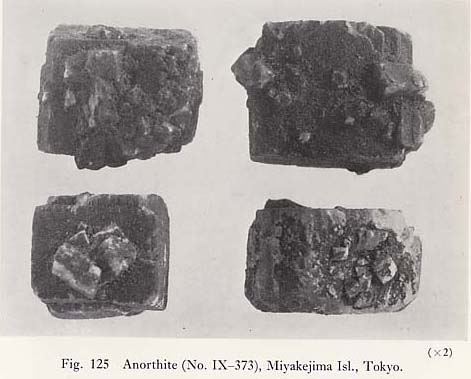
Specimen No. IX-381, from Oshima Isl., Tokyo, occurs in an andesitic
lava as isolated short prismatic crystals attaining a few centimeters in diameter.
Their main faces are c(001), b(010) and y(![]() 01).
01).
Danburite, Ca[B2Si2O8], Rhombic, Pbnm
< Specimens No. IX-382—No. IX-389 > (Fig. 126-128)
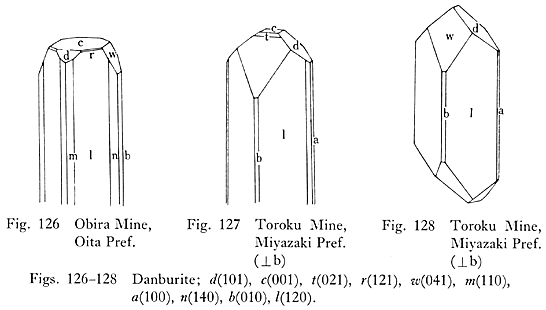
Specimens No. IX-382—No. IX-388, from the Obira Mine, Oita Pref., are a product of pneumatolytic metasomatism. Their crystals form colourless and transparent prisms reaching 1 cm in length. Faces w(041) and l(120) are the largest and commonest, and d(101) is smaller but also common.
Specimen No. IX-389, from the Toroku Mine, Miyazaki Pref., is a product
of pneumatolytic metasomatism in a contact deposit. Its crystals are rhombic
and columnar with d(101) w(041) and l(120), 2 cm in diameter, 7 cm in length,
white and translucent, partially colourless and transparent (Fig. 129).
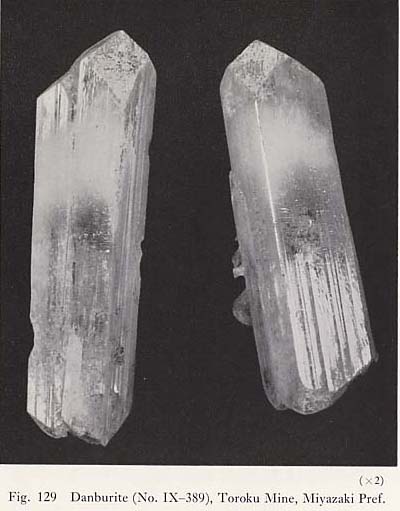
Sodalite, Na8[Cl2|(AlSiO4)6],
Cubic, P![]() 3n
3n
< Specimens No. IX-390—No. IX-393 >
Specimens No. IX-390—No. IX-393, from Pokchin-san, Korea, occur as veins in nepheline-syenite, and form blue masses associated with zircon, biotite, nepheline and orthoclase.
Natrolite, Na2[Al2Si3O10]·2H2O, Rhombic, Fdd2
< Specimen No. IX-394 >
Specimen No. IX-394, from Maze, Niigata Pref., occurs in cavities in a basaltic agglomerate, and forms globules of fibrous or acicular crystals of radial texture. The acicular crystals measure 1 cm in length on an average.
Thomsonite, NaCa2[Al2(Al, Si)Si2O10]2·6H2O, Rhombic, Pnn2
< Specimen No. IX-395 >
Specimen No. IX-395, from Namjoo-ri, Korea, occurs as vein mineral in a basaltic rock, and is a white radial aggregate of fibrous crystals.
Mordenite, (Ca, K2, Na2) [AlSi5O12]2·6H2O, Rhombic, Cmc21
< Specimen No. IX-396 >
Specimen No. IX-396, from Arasawa, Iwate Pref., forms white, transparent and fibrous crystals filling amygdules in rhyolite, sometimes in cotton like aggregates.
Laumontite, Ca[AlSi2O6]2·4H2O, Monoclinic, C2 or Cm
< Specimens No. IX-397—No. IX-399 >
Specimens Nos. IX-397 & IX-398, from Menashidomari, Hokkaido, are aggregates of white powdery or acicular crystals filling fractures in tuff. It is highly dehydrated owing to prolonged exposure to open air.
Specimen No. IX-399, from the Kanagase Deposit of the Ikuno Mine, Hyogo Pref., is pale pink aggregate of needle-shaped crystals filling amygdules of andesite.
Heulandite, Ca[Al2Si7O18]·6H2O, Monoclinic, C2/m
< Specimens No. IX-400—No. IX-404 >
Specimen No. IX-400, from Obara, Miyagi Pref., occurs in an amygdule
of andesite. Its crystals are white, transparent, prismatic or tabular, and
1 cm in length. Faces observed are t(201) m(110) s(![]() 01)
b(010) and c(001). Associated minerals are apophyllite, stilbite and calcite.
01)
b(010) and c(001). Associated minerals are apophyllite, stilbite and calcite.
Specimens No. IX-401—No. IX-404, from Chichijima Isl., Tokyo,
occur in amygdules of andesite, forming aggregates of pale yellowish and transparent
thick tabular crystals with t(201), m(110), s(![]() 01),
b(010) and c(001). The large crystals measure 1 cm in diameter. Calcite and
mordenite are associated.
01),
b(010) and c(001). The large crystals measure 1 cm in diameter. Calcite and
mordenite are associated.
Stilbite, Ca[Al2Si7O18]·7H2O, Monoclinic, C2/m
< Specimens No. IX-405—No. IX-408 >
Specimens No. IX-405—No. IX-407, from Obara, Miyagi Pref., are white and transparent crystals 1 cm across and occurring in drusy cavities in andesite in association with calcite and heulandite.
Specimen No. IX-408, from Kurokura, Kanagawa Pref., occurs in a quartz
vein cutting through diorite, and forms bundle-shaped aggregates of white
prismatic crystals up to 1 cm in length. Faces observed are c(001), m(110)
and b(010). Acicular crystals of natrolite are associated (Fig. 130).

Epistilbite, Ca[Al2Si6O16]·5H2O, Monoclinic, C2/m
< Specimen No. IX-409 >
Specimen No. IX-409, from Hirogawara, Kanagawa Pref., occurs in amygdules of dolerite as transparent envelope-shaped crystals measuring a few millimeters in diameter and associated with crystalline quartz.
Yugawaralite, Ca[Al2Si6O16]·4H2O, Monoclinic, Pc
< Specimen No. IX-410 >
Specimen No. IX-410, from the Yugawara Hot Spring, Kanagawa Pref., is white and translucent tabular crystals filling fractures of an andesitic tuff and measuring a few millimeters in diameter.
Chabazite, (Ca, Na2)[Al2Si4O12]·6H2O,
Trigonal, R![]() m
m
< Specimens No. IX-411—No. IX-424 >
Specimens Nos. IX-411 & IX-412, from Mitaki, Miyagi Pref., occur in
cavities of andesite or andesitic agglomerates. They form pseudo-hexagonal
double pyramidal crystals pale pink to colourless, about 3 mm in diameter.
and with rough and dull faces (Fig. 131).

Specimens Nos. IX-413 & IX-414, from Osawa, Tochigi Pref., occur on chalcedonic quartz surrounding amygdules in andesite. The transparent crystals are rhombohedral with r(111), measuring 5 mm across.
Specimen No. IX-415, from Mitaka, Shizuoka Pref., is transparent rhombic
crystals in drusy cavities in an andesitic tuff, 3 mm in diameter and with
r(10![]() 1).
1).
Specimen No. IX-416, from Nashimoto, Shizuoka Pref., lines a drusy
cavity in basalt with natrolite and epistilbite. Its crystals are transparent,
up to a few millimeters in diameter and with r(10![]() 1).
1).
Specimens No. IX-417—No. IX-419, from Tokura, Shizuoka Pref.,
occur in cavities in an andesitic tuff, and form transparent rhombic crystals
up to 5 mm in length and with r(10![]() 1).
Associated minerals are pale green prehnite, white acicular aggregates of
laumontite, and quartz.
1).
Associated minerals are pale green prehnite, white acicular aggregates of
laumontite, and quartz.
Specimen No. IX-420, from the Naegi District, Gifu Pref., is yellowish brown crystals, a few millimeters across, occurring in drusy cavities in a granitic pegmatite in association with microcline and smoky quartz.
Specimen No. IX-421, from Imayama, Fukuoka Pref., occurs as rhombhedral crystals in amygdules in basalt. They are transparent and a few millimeters across.
Specimens No. IX-422—No. IX-424, from Seoksoo-dong, Korea, occur
in druses in andesite, forming aggregates of pale yellow and transparent rhombic
crystals reaching 5 mm in diameter. Their dominant face is r(10![]() 1).
1).